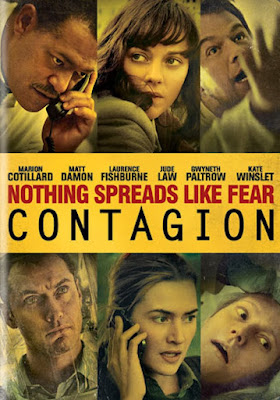Who’da thunk I’d watch a disaster movie and feel . . . nostalgia? But that was my first reaction when viewing Contagion, the 2011 medical disaster movie directed by the very busy Steven Soderbergh. I first became a Soderbergh fan after seeing 1989’s sex, lies, and videotape, a modest but emotionally dynamic chamber piece that won the Palme d’Or at the Cannes Film Festival and ushered in an era of adult-themed indies made by serious young filmmakers. Since then, Soderbergh has had a solid career in film and television, including Erin Brockovich, the multiple Oscar-winning Traffic, and a sexy George Clooney/Jennifer Lopez thriller, Out of Sight. For variety he’s helmed some lucrative franchises like Ocean’s Eleven and its sequels.
When it was released in 2011, Contagion did nicely at the box office. Its impressive cast and far-flung settings attracted viewers around the globe, eager to see such major stars as Gwyneth Paltrow, Matt Damon, Marion Cotillard, Laurence Fishburne, Kate Winslet, and Jude Law fight off a worldwide pandemic. But I doubt anyone took it terribly seriously. After all, in 2011 we hadn’t endured a true global medical disaster for almost 100 years. Not since 1918, and the latter days of World War I, had the world seen the so-called Spanish Flu epidemic that took the life of my mother’s father, as well as millions of others. It was exciting to watch Paltrow and Winslet in the throes of a horrible virus, but we knew perfectly well that we and our loved ones were safe.
That was then. Now that we’ve been through 3½ years of COVID, I could watch Contagion from a new, more enlightened perspective. A lot of what appears on screen seems all too familiar: the origin of the virus among tainted bats and pigs in a Chinese marketplace; the spreading of the disease, in those first innocent days, from simple hand-to-hand contact; the fear behind every cough as the world starts to catch on to what is happening; the grimly mounting statistics on the TV screen; the desperate urge for a vaccine that will return the world to the way it was before. The filmmakers presciently show so many things that became all too familiar in 2020, like the turning of football stadiums into mass hospitalization sites. And there’s Jude Law’s blogger character, who evolves into an anti-vaxer urging the public to avoid vaccination altogether. Sound familiar?
Some things that are shown in the film fortunately didn’t happen in real life. First of all, the film’s eventual miracle vaccine is injected into the nasal cavity (yuck!), something we fortunately haven’t had to deal with. Secondly, though some of us did help strip store shelves bare of toilet paper, we didn’t run out of food and find ourselves making do with MREs, like the movie’s characters. Nor, at least in my experience, did real-life vaccine injection sites devolve into vicious brawls as people fought over scarce resources. Another of the film’s plot strands has the U.S. and its western allies cynically sending placebos overseas so as to hang onto the precious dosages for their own populations. In some ways we’ve been very lucky that these hideous movie scenarios haven’t played out for real.
Yet the movie overlooks some issues that we’ve had to acknowledge in the real world. Like: the fact that deaths from COVID have been very much linked to social class, with hard-working ethnic minorities (of which the film has very few) bearing the brunt of the infection. Contagion’s innocence in such matters makes it seem rather quaint. Still, we can’t say we weren’t warned.


No comments:
Post a Comment